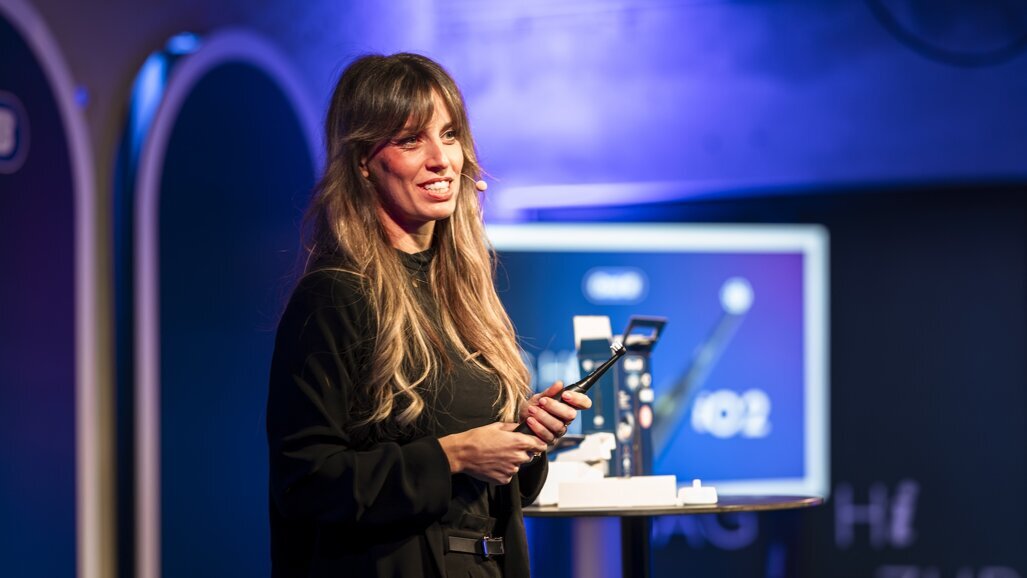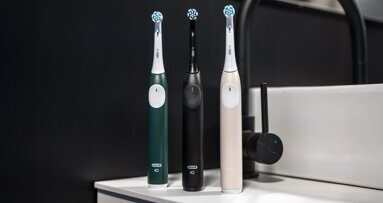Just recently, Oral‑B senior scientist Dr Maria Wegemann presented the new Oral‑B iO2 toothbrush to media representatives at the launch event in Germany, and Dental Tribune International had the opportunity to speak with her. Dr Wegemann is research and development (R & D) product innovation manager at Procter & Gamble, which owns the Oral‑B brand, and she leads efforts to create new products that both meet consumer needs and incorporate the latest advancements in technology. In this interview, she talks about what stops manual toothbrush users from switching to an electric one and how the Oral-B iO2 addresses these concerns.
Dr Wegemann, you have an academic background in food processing, biology and chemistry. Has this interdisciplinary expertise influenced your approach to product innovation?
I would call myself a generalist because I enjoy working across different fields. My role in product research bridges the gap between lab work, prototype development and consumer needs. Thanks to my background in food science and my PhD in pharmaceutical chemistry, I’m able to understand the product needs and translate them into technical features, collaborating closely with engineers and marketing teams. While I’m not an engineering expert, I bring valuable insight into how the product should serve consumers’ needs.
How do you establish what consumers need?
We always start our development process with consumers. We start with understanding their needs and aspirations. Are there any features they want? For the Oral-B iO2 in particular, I talked to users of manual toothbrushes only so that we could understand why we should and how we could develop an electric toothbrush that they would want to use in their daily routine. One of the key barriers to using an electric toothbrush that we discovered is complexity. Manual toothbrush users want something simple. They don’t want to have a display or two buttons. What do they do with the second button? A simple design is important. A lot of the other issues we uncovered were about a feeling of difficulty and harshness. They said that electric toothbrushes feel too harsh in their mouth and that they were concerned about using the brush incorrectly and hurting the gums or the teeth by pressing too hard. The higher cost of electric toothbrushes can be a barrier to switching to an electric toothbrush as well. This all came out of interviews that we did with consumers around the globe. We always do our research around the globe, because we want to understand everyone, and then we can narrow down the feedback.
So we decided to work on these two barriers, a complex design and harshness. A third issue that arose was whether or not manual toothbrush users really needed to switch, having brushed manually their whole lives and many never having had any issues with doing so. We addressed this by explaining that, as Dr Daniel Grotzer mentioned, 90% of people will have oral care issues in their lifetime, so it makes sense to invest in one’s oral health to get the best oral care possible. We also addressed the fear of using electric toothbrushes incorrectly, much like cleaning your house with a broom when a vacuum cleaner could do the job more efficiently.
What key factors drove the decision to release a new model in the Oral‑B iO range?
We brought the iO Series 3–10 to the market, but we noticed that we were still not getting manual users to switch to electric, and this was the key motivation for us to design a brush which could give manual users the motivation to switch. All the other brushes in the iO series offer different features. They have two buttons, a display, the app and so on. It seems that all these functions had put manual users off from even trying an Oral‑B iO brush.
What are the main differences and features of the Oral-B iO2?
The Oral-B iO2 offers similar cleaning performance to the higher-end models, including vibrations that ensure effective plaque removal. However, it’s simpler in design, omitting the display and app features. It includes key functions like pressure control, which alerts users if they’re applying too much pressure with a light on the handle, and a timer that provides feedback through vibrations.
How do you and your team integrate scientific research into developing new dental care products?
We integrate scientific research into product development by constantly collaborating with leading researchers, dental professionals and external institutions. Through clinical studies, consumer feedback and partnerships with universities, we ensure that our products are based on the latest scientific findings. Research guides every stage, from selecting the most effective materials and technologies to refining the performance of our products to meet the needs of both dental professionals and consumers.
How are you keeping your R & D efforts in line with the increasing adoption of artificial intelligence (AI) and the advancements in digital and preventive care?
We incorporate AI extensively in our R & D process, especially for consumer research. AI helps us analyse both active and passive data—such as online reviews—allowing us to identify trends and feedback related to our products. By using AI tools to analyse this data, we gain valuable insights into consumer perceptions and can refine our products accordingly.
Topics:
Tags:
Recently, Oral‑B introduced its Oral-B iO Series 2 (iO2) electric toothbrush at an event in Germany. One of the speakers was Dr Daniel P. Grotzer, who...
BERLIN, Germany: Oral-B has unveiled its Oral-B iO Series 2 (iO2), a new model in its revolutionary iO technology range. The Oral-B iO2 is being introduced ...
Live webinar
Mon. 22 December 2025
1:00 pm EST (New York)
Live webinar
Mon. 12 January 2026
9:00 am EST (New York)
Prof. Judith Jones D.D.S; M.P.H., Prof. Kakuhiro Fukai D.D.S., Ph.D, Dr. Bathsheba (Bethy) Turton
Live webinar
Wed. 14 January 2026
12:00 pm EST (New York)
Dr. Théo Laplane, Dr. Robert Gottlander DDS
Live webinar
Fri. 16 January 2026
12:00 pm EST (New York)
Live webinar
Mon. 19 January 2026
1:00 pm EST (New York)
Philipp Kopp, Michael Seeber
Live webinar
Thu. 22 January 2026
2:00 pm EST (New York)
Dr. Nicola M. Grande DDS, PhD
Live webinar
Wed. 28 January 2026
8:00 am EST (New York)



 Austria / Österreich
Austria / Österreich
 Bosnia and Herzegovina / Босна и Херцеговина
Bosnia and Herzegovina / Босна и Херцеговина
 Bulgaria / България
Bulgaria / България
 Croatia / Hrvatska
Croatia / Hrvatska
 Czech Republic & Slovakia / Česká republika & Slovensko
Czech Republic & Slovakia / Česká republika & Slovensko
 France / France
France / France
 Germany / Deutschland
Germany / Deutschland
 Greece / ΕΛΛΑΔΑ
Greece / ΕΛΛΑΔΑ
 Hungary / Hungary
Hungary / Hungary
 Italy / Italia
Italy / Italia
 Netherlands / Nederland
Netherlands / Nederland
 Nordic / Nordic
Nordic / Nordic
 Poland / Polska
Poland / Polska
 Portugal / Portugal
Portugal / Portugal
 Romania & Moldova / România & Moldova
Romania & Moldova / România & Moldova
 Slovenia / Slovenija
Slovenia / Slovenija
 Serbia & Montenegro / Србија и Црна Гора
Serbia & Montenegro / Србија и Црна Гора
 Spain / España
Spain / España
 Switzerland / Schweiz
Switzerland / Schweiz
 Turkey / Türkiye
Turkey / Türkiye
 UK & Ireland / UK & Ireland
UK & Ireland / UK & Ireland
 Brazil / Brasil
Brazil / Brasil
 Canada / Canada
Canada / Canada
 Latin America / Latinoamérica
Latin America / Latinoamérica
 USA / USA
USA / USA
 China / 中国
China / 中国
 India / भारत गणराज्य
India / भारत गणराज्य
 Pakistan / Pākistān
Pakistan / Pākistān
 Vietnam / Việt Nam
Vietnam / Việt Nam
 ASEAN / ASEAN
ASEAN / ASEAN
 Israel / מְדִינַת יִשְׂרָאֵל
Israel / מְדִינַת יִשְׂרָאֵל
 Algeria, Morocco & Tunisia / الجزائر والمغرب وتونس
Algeria, Morocco & Tunisia / الجزائر والمغرب وتونس
 Middle East / Middle East
Middle East / Middle East







































To post a reply please login or register